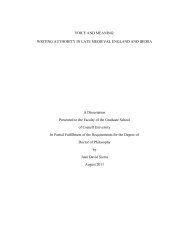CARPET WEAVERS AND WEAVING IN THE ... - Cornell University
CARPET WEAVERS AND WEAVING IN THE ... - Cornell University
CARPET WEAVERS AND WEAVING IN THE ... - Cornell University
Create successful ePaper yourself
Turn your PDF publications into a flip-book with our unique Google optimized e-Paper software.
1992, Gumen 1989). Responsibilities change from region to region, village to village,<br />
and even house to house, with women from wealthier families only working in the<br />
fields when hired labor is scarce (Morvaridi 1992, 574). Though a wide variety of<br />
tasks can be assigned to women, they are not involved in agricultural management<br />
(Akpinar et al. 2004, Moravidi 1992).<br />
While women may take on men’s tasks when there is a lack of male labor or<br />
when men migrate for work, men never take on tasks assigned to women (Akpinar et<br />
al. 2004, Morvaridi 1992, Kandiyoti 1990). Women’s labor is often viewed by both<br />
women themselves and the men in their families as an extension of their household<br />
responsibilities and thus not as a “real job”. It is cheaper to hire a woman to work in<br />
the fields than to rent farm equipment, and cheaper still to rely on unpaid family labor,<br />
thus new technology is more likely to be adopted to facilitate men’s labor as opposed<br />
to women’s (Morvaridi 1992, 574). This is also true because men control the<br />
household’s money (no matter who actually earned it) and make decisions about how<br />
the money will be spent (Kandiyoti 1990, 101).<br />
Since women risk social standing by communicating with non-kin men, men of<br />
the household are generally the ones who negotiate contracts for women’s labor or sell<br />
the products thereof (Akpinar et al. 2004, Moravidi 1992). Owing to the fact that men<br />
view women’s work as an extension of their responsibilities as wives and daughters<br />
they often undervalue women’s labor (Akpinar et al. 2004). As unpaid laborers<br />
women act as a buffer to help the family through financial hardship. Their labor for<br />
specific tasks is utilized as necessary, but when it is no longer needed they have other<br />
duties to attend to (Morvaridi 1992, 579).<br />
Nonetheless, women are aware of their position as breadwinners and know that<br />
they can perform all of the tasks necessary to keep the household running. One<br />
woman in Morvaridi’s study said, “We can survive without our men. The only thing<br />
18

















